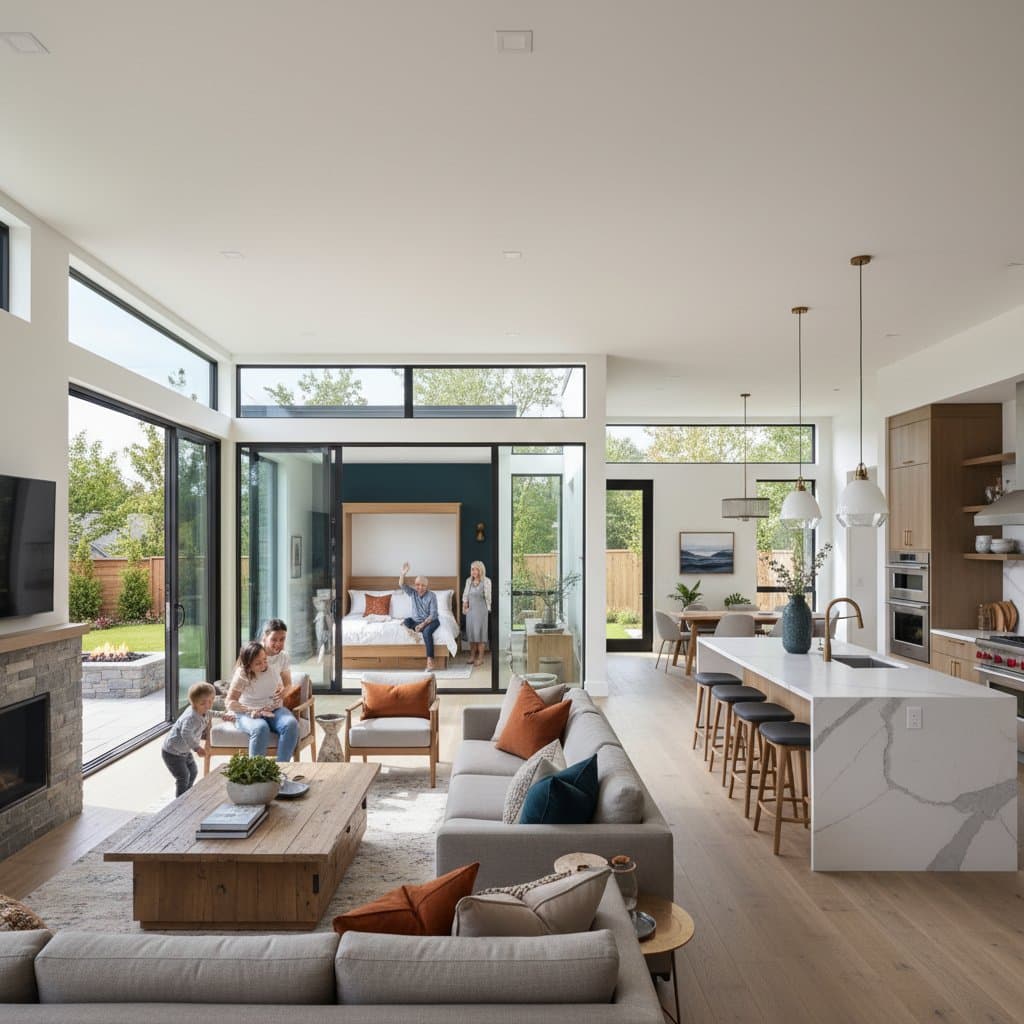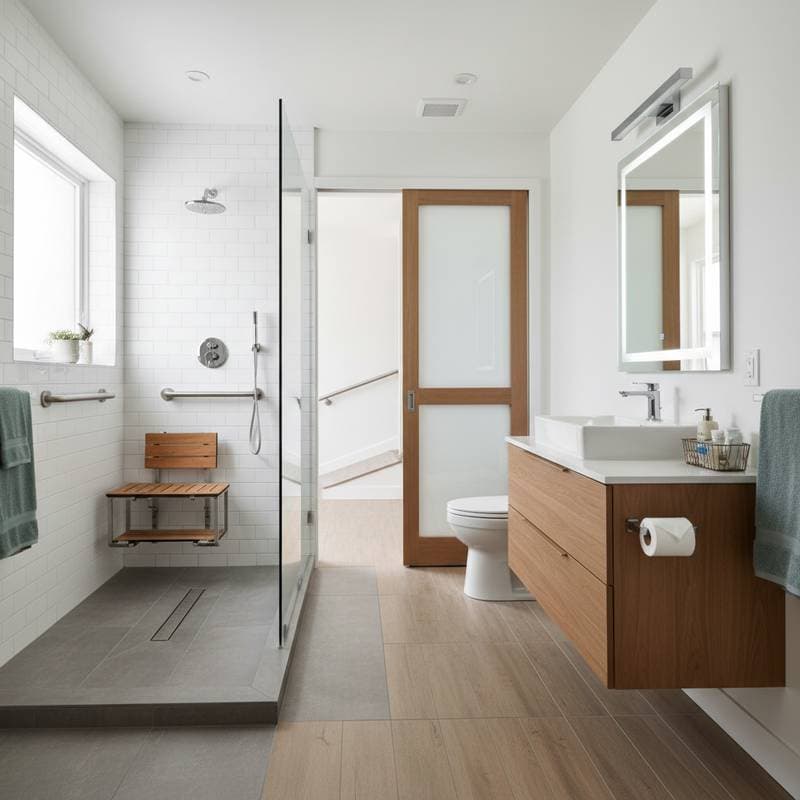Wet Room vs Traditional: 2025 Remodel Showdown
Planning a bathroom remodel requires careful consideration of layout options. The choice between a traditional setup and a wet room influences daily use, cleaning routines, and overall enjoyment. This guide examines key differences to help select the design that aligns with personal needs, accessibility preferences, and long-term home value.
Understanding the Core Concepts
A traditional bathroom employs enclosures, curbs, or glass doors to separate the shower or tub from other areas. This approach contains water within a specific zone, preserving the dryness of surrounding surfaces.
In contrast, a wet room eliminates these barriers. Waterproofing covers the entire floor, allowing the shower area to integrate seamlessly with the room. This creates an open, barrier-free environment that enhances accessibility and visual continuity.
Both designs achieve aesthetic appeal and functionality, yet they demand distinct maintenance strategies and user experiences.
Accessibility and Daily Function
Wet rooms provide barrier-free entry to the shower, eliminating steps or curbs. This feature benefits individuals of all ages and mobility levels, minimizing fall risks and facilitating effortless movement.
The open layout promotes an inclusive, modern feel. It proves particularly suitable for homes anticipating long-term residency or adapting to changing physical needs.
Traditional bathrooms confine water to an enclosed shower or tub. This setup suits households that value distinct bathing zones and require control over water splash.
Enclosures safeguard adjacent elements like cabinets and mirrors from excess moisture, supporting reliable performance in active family environments.
Waterproofing Essentials and Maintenance Practices
Wet rooms necessitate comprehensive waterproofing, including subfloor membranes, sealed joints, and sloped flooring directed toward drains. Proper installation prevents water intrusion and structural damage.
Once established, maintenance simplifies due to the absence of enclosures. A continuous surface enables straightforward rinsing, and materials such as tile or microcement resist mold when paired with effective ventilation.
Traditional bathrooms rely on enclosure seals, caulking, and exhaust fans for moisture management. Regular inspections ensure longevity and prevent humidity-related issues.
Targeted upkeep focuses on enclosed areas, allowing straightforward grout replacement or fixture adjustments without altering the broader space.
Design Aesthetics and Spatial Impact
Wet rooms foster a sense of expansiveness by removing partitions, ideal for compact bathrooms. Uninterrupted tile patterns across floors and walls enhance visual flow and perceived size.
For optimal results, select large-format porcelain tiles or stone-inspired finishes. A frameless glass panel offers subtle division while preserving openness.
Traditional designs introduce structured zones that add depth and variety. Accent materials in the shower area can highlight architectural features.
Pair classic white subway tiles with matte black fixtures for enduring elegance, or incorporate soft neutral tones to evoke warmth and tradition.
Installation Costs and Professional Guidance
Converting to a wet room involves skilled labor for precise waterproofing and drainage slopes. These elements elevate upfront expenses, particularly in retrofits from existing traditional layouts.
Reserve DIY efforts for surface-level changes like minor tiling. Engage a licensed contractor for full installations to guarantee leak-proof integrity.
Traditional renovations typically incur lower costs, as plumbing and drainage configurations remain intact. Updates to tiles, paint, or fixtures proceed without major structural modifications.
Handle tasks such as painting or hardware replacement independently. Professional assistance becomes essential for extensive tile work or shower overhauls.
Comfort Factors and Environmental Adaptations
Open wet room designs may introduce cooler temperatures if insulation lacks attention. Incorporate underfloor heating systems or heated towel racks to sustain warmth.
Prioritize slip-resistant flooring certified for wet conditions, ensuring both safety and comfortable footing.
Enclosed traditional bathrooms retain heat and steam effectively, fostering a soothing atmosphere during bathing. This proves advantageous in cooler climates or seasonal transitions.
Balance ventilation to manage humidity without excessive heat loss. Adequate airflow prevents condensation while preserving coziness.
Aesthetic Trends and Resale Implications
Wet rooms embody a contemporary, spa-inspired vibe that attracts those favoring minimalism and universal access. This style elevates modern home aesthetics.
Traditional bathrooms maintain broad appeal across diverse property types. Enclosed setups provide familiar privacy and align with conventional buyer expectations.
Align the design with your home's architectural character to maximize resale potential. Wet rooms complement sleek, contemporary structures, whereas traditional layouts enhance period homes like colonials or farmhouses.
Selecting and Implementing the Ideal Design
Thoughtful planning ensures that either a wet room or traditional bathroom delivers enduring comfort and utility. Evaluate lifestyle habits, financial parameters, and desired ambiance to guide the decision.
Opt for a wet room to prioritize seamless cleaning, accessibility, and contemporary flair. Choose traditional elements for structured warmth and established practicality.
Consult a specialist contractor versed in both approaches. They evaluate site conditions, recommend waterproofing techniques, and tailor solutions to future requirements.
Ultimately, a well-executed remodel enhances routine satisfaction and bolsters property investment.











